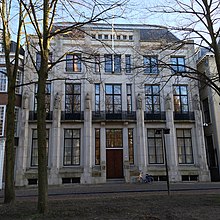Dutch Safety Board
| Onderzoeksraad voor Veiligheid OVV | |
 | |
 Office of the Dutch Safety Board | |
| Agency overview | |
|---|---|
| Formed | 2005 |
| Jurisdiction | The Netherlands |
| Headquarters | Lange Voorhout 9, The Hague |
| Website | onderzoeksraad |
The Dutch Safety Board (DSB; Dutch: Onderzoeksraad voor Veiligheid, OVV, literally "Investigation Council for Safety") is the official body that investigates a wide variety of safety matters in the Netherlands. It is based in The Hague.[1][2]
History
The DSB was created in 2005 after the Enschede fireworks disaster and the Volendam café fire.[2] The board was formed from a merger between the defence and public transportation safety boards. It replaced the Dutch Transport Safety Board.[3]
The first DSB Chairman was Pieter van Vollenhoven, who served from 2005 until 2011. He was succeeded by Tjibbe Joustra, who retired in 2019; he was succeeded by former Finance Minister Jeroen Dijsselbloem.[4][5]
As of 2012, the DSB actively investigates accidents and incidents related to aviation, construction and services, crisis management and aid provision, defence, human and animal health care, industry and networks, pipelines, rail transport, shipping, as well as water. The DSB has the authorisation to investigate accidents and incidents in any conceivable field.[6]
The National Bureau of Air Accidents Investigation of Ukraine (NBAAI) had requested that the DSB participate in the international investigation of Malaysia Airlines Flight 17; the DSB received formal notice of the accident from the NBAAI on 18 July 2014.[7] The NBAAI delegated the investigation to the DSB because of the large number of Dutch passengers and the fact that the flight originated in Amsterdam.[8]
As a result of the 2017 fipronil egg scandal, the Dutch Safety Board announced on 8 August that an official investigation had been initiated.[9]
Areas of investigations
Operational sectors of investigations include:
- Aviation (commercial, passenger and private aviation)
- Shipping (inland navigation and some segments of recreational navigation)
- Rail transport (railways and increasingly also tram, metro and light rail)
- Road transport (due to the high number of accidents, only thematic investigations)
- Pipelines (pipelines, public utilities included)
- Defence (military aviation, navigation, road transport, underground infrastructure)
- Industry and trade (heavy industry (especially process industry, labour accidents))
- Crisis management and aid provision (performance of aid and control services)
- Healthcare (human and animal)
- Nature and environment (impact of aviation, marine operations, railroad and transportation)
Structure
The board acts as an autonomous organisation. Its code of conduct is established by law.
The organisation consists of a Board and a Bureau. The Board has five permanent members, the Bureau fulfills executive tasks.
See also
- Turkish Airlines Flight 1951
- Sloterdijk train collision
- Netherlands Aviation Safety Board (predecessor agency)
- Aircraft Incident Management Procedure (Netherlands)
References
- ^ "Contact". Dutch Safety Board. Retrieved 15 January 2023.
Visiting address Lange Voorhout 9 2514 EA The Hague
- ^ a b "History of the Safety Board." Dutch Safety Board. Retrieved 29 April 2009.
- ^ Kingdom Act Instituting a Safety Investigation Board (Kingdom Act concerning Safety Investigation Board) (PDF),
to prepare a legislative proposal in order to come to one independent investigation board for disasters and major accidents
- ^ "Joustra voorzitter Onderzoeksraad" (in Dutch). NOS. 15 September 2010. Retrieved 16 September 2010.
- ^ Dutch government (17 September 2010). "Joustra voorzitter Onderzoeksraad voor veiligheid" (in Dutch). Dutch ministry of General Affairs. Archived from the original on 13 April 2015. Retrieved 19 September 2010.
- ^ "The Dutch Safety Board Archived 2 May 2009 at the Wayback Machine." Dutch Safety Board. Retrieved 17 January 2012.
- ^ "Investigation crash MH17, 17 July 2014 Donetsk Introduction" (Archive). Dutch Safety Board. Retrieved 2 August 2014. "The Dutch Safety Board was formally informed on the air disaster by its Ukrainian counterpart (NBAAI) on 18 July 2014. The NBAAI also requested the Dutch Safety Board to participate in the international investigation. "
- ^ "Investigation crash MH17, 17 July 2014 Archived 16 June 2018 at the Wayback Machine." Dutch Safety Board. Retrieved 22 August 2014. "Ukraine has transferred responsibility for investigating the cause of the crash to the Dutch Safety Board. The request came from Ukraine. This request was made because the flight departed from the Netherlands, and due to the large number of Dutch nationals who died in the crash"
- ^ "Onderzoeksraad voor Veiligheid | Onderzoeken & Publicaties | Onderzoek vanwege fipronil in voedselketen". Archived from the original on 9 August 2017. Retrieved 10 August 2017.
Sources
This article incorporates text from www.safetyboard.nl, a public domain work of the Dutch government.
External links
- Dutch Safety Board (in English)
- Dutch Safety Board (in Dutch)
- Dutch Safety Board (in English) (Archive)
